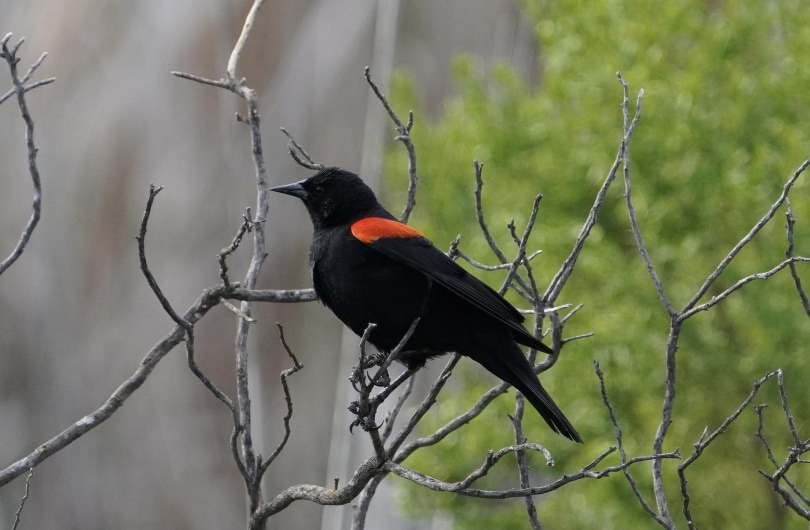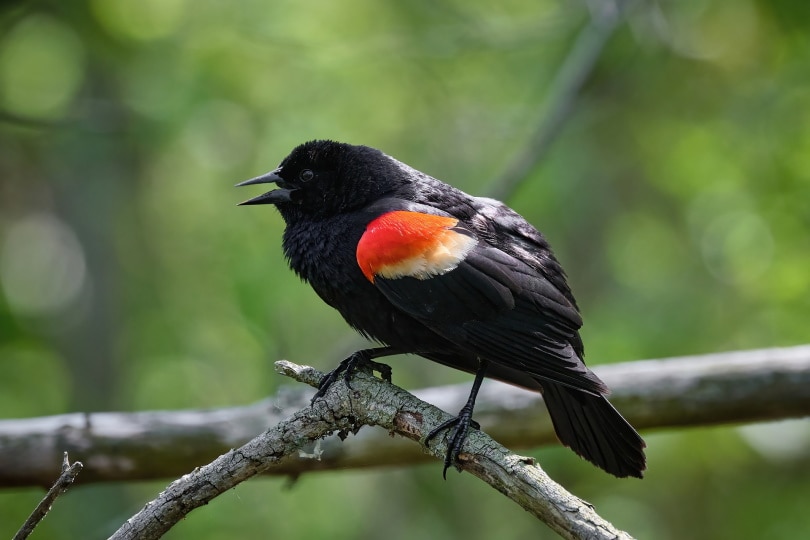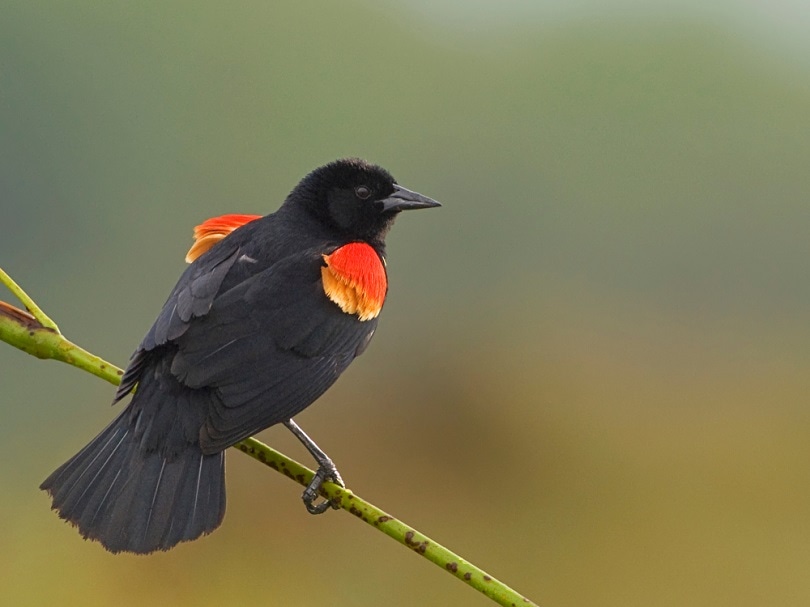Red-Winged Blackbird: Field Guide, Pictures, Habitat & Info
Last Updated on

Red-winged blackbirds are one of the most abundant bird breeds across North America. They are recognized by their bold, red-colored wings that look even more prominent on their jet-black bodies. Male Red-winged Blackbirds have scarlet and yellow shoulder patches1, while females are steaky brown like a big, dark sparrow.
These birds are found with subtle variations across different parts of the country. The most common type is the Bicolored Blackbird in coastal California, which lacks a yellow border on its red shoulders.
Red-winged Blackbirds are ground foragers but are also found sitting on telephone wires and soggy roadsides or marshes. Whenever you hear Red-winged Blackbirds’ “conk-la-lee!” song, know that the spring season has arrived.

Quick Facts about the Red-winged Blackbird
| Habitat | Marshes |
| Diet | Insects |
| Behavior | Ground forager |
| Nesting | Shrub |
| Conservation | Low concern, populated |
| Scientific name | Agelaius phoeniceus |
| Lifespan | 2–16 years |
Red-Winged Blackbird: General Description
Red-winged Blackbirds fly all over North America. These are large, broad-shouldered birds with slender, conical bills, and medium tails. When perching, Red-winged Blackbirds look hump-backed. Males, specifically, sit with slightly flared tails.
Male Red-winged Blackbirds have glossy black bodies with red and yellow shoulder patches. Females are dark brown, paler from the breast, and often have whitish eyebrows.
The oldest Red-winged Blackbird recorded was 15 years and 9 months old. However, the general lifespan of these birds is 2–16 years. They feed on insects, although they also eat lizards, worms, snails, and similar species.

Red-Winged Blackbird: Range, Habitat, Behavior, Diet & Nesting
The striking black color and red wings of Red-winged Blackbirds are enough to grab your attention, but there is more to this bird species. Here is what you need to know more about them:
Range
Red-winged Blackbirds can be migratory and non-migratory. They are either resident birds or short-distance migrants.
In northern parts of North America, these birds migrate to the Southern United States for about 800 miles from their breeding ranges. However, birds in the southern and western areas don’t migrate, even for shorter distances.
Habitat
On your trip to North America, look for these birds in salt water and fresh marshes. You may also find them alongside water hazards on sports, water courses, and wet roadsides. In winter, Red-winged Blackbirds also live in crop fields, pastures, old fields, drier meadows, and feedlots.
Behavior
Male Red-winged Blackbirds sing their favorite “conk-la-ree!” song the entire day. They sit on high perches to gather birdwatchers’ attention. Females tend to stay on the ground, searching through vegetation to find different types of food. They also make their nests while staying low.
Red-winged Blackbirds come together in huge flocks to feed on grains when winters come. They also get well with other blackbird species and starlings.
Males are the best defenders of their territories during the breeding season. They serve as the protector of their regions for more than a quarter of the day. They chase other predators out of their area and attack small and large animals, such as horses and even people.

Diet
Red-winged Blackbirds are omnivores, so they feed on various insects, seeds, and plants. In the summer, they hunt insects, lizards, spiders, worms, mollusks, mussels, snails, crayfish, frogs, nestlings, etc.
However, in the winter, they’re mostly found feeding birds’ eggs, corn, fruits, wheat, and berries, and seeds like cocklebur, ragweed, sunflower seeds, and waste grains. Their diet also includes aquatic plants. Red-winged Blackbirds use their slender bills to catch insects and plants.
Nesting
Red-winged Blackbirds build low nests on vertical vegetation shoots of marsh, shrubs, and trees. Females are the primary decision-makers for the nesting venue with little input from the males. Typically, their nests are near the ground or water surface of the marsh.
In some parts, Red-winged Blackbirds also put their nests in dense grass vegetation, including sedges, cattails, phragmites in wetlands, blackberry, alder trees, or goldenrod trees in uplands, and alfalfa, wheat, rice, and barley plants.
How to Find Red-Winged Blackbirds: Birdwatching Tips
Red-wing Blackbirds are easier to identify by their black, red, and yellow colors. However, many people confuse them with similar breeds. If you don’t want to miss sighting these birds the next time you visit North America, don’t forget these birdwatching tips.

What to Listen For
Listen carefully to the “conk-la-ree!” song. It’s the male Red-winged Blackbird trying to gather your attention.
What to Look For
Some distinctive characteristics of Red-winged Blackbirds are:
- Size and Shape: These are stocky blackbirds with a slender bill and a medium tail. They have a hump-backed structure when perching. These birds are about three-quarters the size of a Common Grackle. Males and females have a length of 6.7–9.1 inches (17–23 centimeters) and a weight of 1.1–2.7 ounces (32–77 grams). Their wingspan is 12.2–15.8 inches (31–40 centimeters).
- Color: Males are glossy black with red and yellow shoulder patches. Females are dark brown and crisply streaked. They also have white eyebrows and a paler chest area.
- Behavior: They are ground foragers. You’re most likely to find females on the ground and males on high perches.
When to Look
It’s better to look for these birds in the breeding season. Visit cattail marshes and other wetlands to find these birds. No matter the season, you’re likely to see a Red-winged Blackbird flying near vegetation and standing water.

Attracting Red-Winged Blackbirds to Your Backyard: Tips & Tricks
Red-winged Blackbirds prefer to live in marshes. But since they’re ground foragers, you can attract them to your backyard. However, you need to be careful and vigilant. Here are a few tips to help you:
- Buy Bird Feeders. Red-winged blackbirds can eat from the tray, window, and hopper feeders. Therefore, search for quality feeders and fill them with tasty foods to attract these birds. A vertical feeder with a big perching tray offers ample space for Red-winged Blackbirds to perch easily.
- Choose the Right Feeder Placement. After buying a feeder, place it in the right place where other animals, like cats or squirrels, can’t reach. These birds are ground foragers but can reach feeders placed a few inches above the ground and away from the trees.
- Use Delicious Foods to Tempt the Birds. Red-winged Blackbirds love to eat millet seeds, cracked corn, sunflower seeds, oats, peanut hearts, and milo. So, you can use these foods to attract them to your backyard. Always use high-quality food baits for effective results.
- Regularly Clean the Feeders. Red-winged Blackbirds prefer fresh water. So, if you want to attract them to your backyard and away from their natural habitat, you need to keep the bird feeders clean.
- Go for a Heated Birdbath. On warm days, Red-winged Blackbirds look for water. Placing bird baths in your backyard is the best way to lure these birds. On colder days, the chances are that the water in your birdbath may freeze. So, use a heated bird bath in the winter to attract these birds throughout the year.

Red-Winged Blackbird Conservation: Is This Bird Threatened?
Red-winged Blackbirds can live in various habitats. Due to their immense adaptability, these birds have coped with habitat losses and urbanization over the years.
Yet, unfortunately, the North American Breeding Bird Survey says that the Red-winged Blackbird populations have declined considerably by around 0.72% annually from 1966 to 2019, accumulating to a 28% decline.
According to Partners in Flight, the global breeding population of Red-winged Blackbirds is 180 million, which decreased from 190 million in 1974. However, the Continental Concern Score rates the species an 8 out of 20, indicating that they have a low conservation concern and are available in abundance.
So, whether you live in North America or are planning to go on a trip, you will be amazed by the beautiful singing of these birds. To our delight, Red-winged Blackbirds are not threatened at all.

Conclusion
Red-winged Blackbirds are a common bird species in North America. These birds mostly nest in marshes, wetlands, and vegetation and sit on telephone wires and soggy roadsides.
You can identify the male Red-winged Blackbirds by their striking black bodies with yellow and red shoulder patches. Females are brownish with paler breasts and white eyebrows. You can hear the beautiful singing of males from high perches while the females stay on the ground searching for insects and seeds.
Red-winged Blackbirds have a low conservation concern rate, so don’t forget to witness these black beauties on your next trip.
Featured Image Credit: stephmcblack, Pixabay
Table of Contents
- Quick Facts about the Red-winged Blackbird
- Red-Winged Blackbird: General Description
- Red-Winged Blackbird: Range, Habitat, Behavior, Diet & Nesting
- How to Find Red-Winged Blackbirds: Birdwatching Tips
- Attracting Red-Winged Blackbirds to Your Backyard: Tips & Tricks
- Red-Winged Blackbird Conservation: Is This Bird Threatened?
- Conclusion
About the Author Jeff Weishaupt
Jeff is a tech professional by day, writer, and amateur photographer by night. He's had the privilege of leading software teams for startups to the Fortune 100 over the past two decades. He currently works in the data privacy space. Jeff's amateur photography interests started in 2008 when he got his first DSLR camera, the Canon Rebel. Since then, he's taken tens of thousands of photos. His favorite handheld camera these days is his Google Pixel 6 XL. He loves taking photos of nature and his kids. In 2016, he bought his first drone, the Mavic Pro. Taking photos from the air is an amazing perspective, and he loves to take his drone while traveling.
Related Articles:
Binocular Magnification Chart: Numbers & Distances Compared
10 Types of Hummingbirds in Arkansas (With Pictures)
8 Types of Hummingbirds in Nebraska (With Pictures)
5 Types of Hummingbirds in Idaho (With Pictures)
3 Types of Hummingbirds in Mississippi (With Pictures)
8 Types of Hummingbirds in Kansas (With Pictures)
5 Types of Hummingbirds in West Virginia (With Pictures)
5 Types of Hummingbirds in Ohio (With Pictures)
